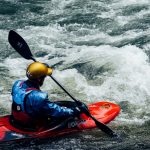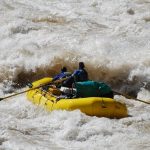Kayaking is a thrilling and immersive water sport that allows you to explore stunning coastlines, navigate rivers, and discover hidden gems of nature.
While enjoying your kayaking adventures, it’s essential to prioritize safety and ensure clear communication on the water.
That’s where VHF radios come into play, providing a reliable means of communication and enhancing your safety while kayaking.
In this guide, we will explore the best VHF radios specifically designed for kayakers.
We understand the importance of choosing a high-quality VHF radio that meets your specific needs and enhances your overall kayaking experience.
Whether you’re embarking on a solo trip or paddling with a group, having a reliable communication device on hand is crucial.
We’ll dive into the features, functionalities, and durability of top-rated VHF radios available in the market.
From compact and waterproof designs to long-range communication capabilities, we’ll help you navigate through the options and select the ideal VHF radio for your kayaking adventures.
Additionally, we’ll provide insights into the key factors to consider when choosing a VHF radio, such as range, battery life, ease of use, and additional features that cater to the unique requirements of kayakers.
We’ll also address common concerns and frequently asked questions to ensure you have all the information needed to make an informed decision.
With our expert recommendations and comprehensive analysis, you’ll be well-equipped to select the best VHF radio that will keep you connected, enhance your safety, and provide peace of mind during your kayaking expeditions.
Let’s dive in and explore the top VHF radios for kayakers, ensuring you’re prepared for your next adventure on the water.
VHF Radios – What are they?
When boaters talk about employing a VHF, they are most likely speaking of a handheld two-way radio that is specifically utilized for maritime needs and operates based on frequencies designated for that purpose.
Among kayakers these are usually handheld “walkie talkie” units. They can be utilized to communicate between vessels, from vessels to harbor masters or traffic control, making “telephone” calls from the sea to the coast, particularly when help is needed in an urgent situation.
The majority of marine radios are able to access weather data transmitted by the National Weather Service (NWS), serving as a reliable source that can help decrease the probability of unexpected weather alterations.
Line-of-sight
VHF radio signals cannot curve around the surface of the planet or go around any impediments. Your radio needs to have an unobstructed view to the antenna it is receiving from.
Coast Guard will install antennas on high mountains or towers located in the Bay Area and other major cities with a high amount of activity, which will enable them to communicate at a long range.
However, when you’re in a tiny kayak, using a rocky outcropping or peninsula as a shield, the signal may not be able to reach you.
It might be a good idea to either relocate to a more distant area near the ocean or travel up a hilltop in order to establish a connection.
Do not forget that marine radios are typically intended for usage at sea, not on land.
Licensing
At the present time, the Federal Communications Commission does not make it mandatory for owners of recreational boats to get a permit to operate a handheld VHF marine radio.
Distress calls
Anyone who has their marine radio powered on and is not already communicating on a different channel must tune into emergency channel 16.
If you find yourself in a dangerous situation and need to summon assistance, make the call over that line.
It is time to call for help with the International Distress Signal “MAYDAY” if it is felt that the situation is serious enough to be a danger to life.
Here’s how:
- Be sure your radio is set to channel 16.
- Press the Transmit (microphone) button and say “MAYDAY” three times.
- Say “THIS IS” one time.
- Give your identification three times.
- Repeat “MAYDAY”.
- Give your location as precisely as you can – either GPS coordinates or bearing and distance (specify magnetic or true if you can be that precise) from a known landmark. Give the best information you can of your course and speed.
- State the nature of your emergency (sinking, hypothermic, etc).
- State the assistance required.
- Give any other information that could help rescuers find/identify/assist you (color of boat, color of PFD, number of people needing assistance, etc.
- Say “OVER” and release the mic button. If you do not get a response in a minute or so, repeat the call. Continue to monitor the radio if possible and be ready to reply when a response comes.
Features to consider when buying
A variety of radio models are available, and marine supply shops usually carry multiple examples of each. Radios sold by a reliable seller typically have the capability to be used for both everyday conversation as well as emergency communications.
So which one should you buy?
Generally speaking, radios with more features tend to cost more than those with fewer features that are bulkier in size. Here are some of the choices you can make:
- Size—Where will you be carrying the radio? Is the smallest one still too big to fit in your PFD pocket?If so, it may not be worth spending the extra money for a compact unit. Will you be putting it in a dry pouch? If so, see what pouch sizes are available & make sure the radio fits.
- “Waterproof” vs. “Submersible”—A radio rated as “Submersible” means it is designed to survive repeated dunkings and still operate.Some, however, are very hard to hear when the speaker is wet – you need to dry it out before you can really use it. And just because it’s rated submersible does not mean that it will float! If you don’t want to use a dry bag, use a lanyard to attach it to your PFD.
- Button vs. knob controls—Remember you may be using this radio with cold hands, with gloves on, and possibly in a dry bag. Big buttons are easiest to use.Small buttons may prove more frustrating than knobs. Some dry bags have a “finger glove” that allows you to get a finger into the bag to operate knobs on top of the radio.
If possible, try operating the radio in a dry bag before buying.
- Power output adjustment—Some radios allow you to choose between two power settings (typically 1 watt vs. 5 watt) for transmitting.A lower setting may slightly reduce your transmit range, but it will draw less power from the battery. Having the option of choosing allows you to conserve battery life when making short range calls, yet you have the higher power available if needed.
Remember that most of the time in a kayak your range is probably going to be limited by the height of your antenna and line-of-sight rather than the power output of the transmitter, so you will rarely get much advantage from the higher power setting.
Note that this power choice only effects how quickly the battery is drained while transmitting; not when the unit is switched on for reception only.
- Multiple channel operation—Some radios have “scanner” functions or at least allow you to monitor two channels simultaneously.Usually you will monitor the emergency/hailing channel (16), and be able to converse with your pod mates on another channel.
In areas with commercial shipping, it can also be helpful to monitor traffic control channels.
Scanning ALL channels constantly can be frustrating; the better units allow you to program only selected channels to scan amongst.
- Rechargeable vs. replaceable batteries—Rechargeable batteries are certainly more environmentally friendly than constantly throwing away disposables.On the other hand, if you are on an extended expedition and do not have access to electrical power to recharge your batteries, the radio may be useless by the end of the trip. You can always carry spare disposable batteries.
Some radios have the option of using either a rechargeable or disposable batteries, so you can have the best of both worlds. See the Glossary for more information on battery types.
- Weather broadcast monitoring—Most handheld VHFs these days also can receive weather information broadcast by the NWS.Although you should not consider any forecast to be 100% accurate for the area you are paddling, this regional information may help keep you from being surprised by a nasty change in the weather.
4 of the best kayak VHF radios
IC-M37E Buoyant Marine VHF Handheld
This VHF radio is both practical and stylish, making it simple to use with a number of useful functions and a decent transmission range.
Specs
Suggested Retail Cost: £219 Weight: 293g/10.3oz Dimensions: 59.7 x 140.5 x 38.7mm Battery Life with Full Charge: 12 hours Waterproof Protection Rating: IPX7 (able to stay safe under 1m of water for up to half an hour) Power: 6W RF output power/ 700 mW audio output Who it is Best for: nightclubs, lone persons and commercial customers. Ideal for sailors who also kayak
This VHF radio, the IC-M37E, is great for use by both sailors and kayakers due to its ergonomic design and ease of use. It features an array of features and is simply designed to fit nicely in the hand. The IC-M37E is equipped with a built-in charging unit and after it is filled with power, the lithium-ion battery will last over 12 hours of use (including 40 minutes of transmitting time).
This package contains an additional battery pack designed to take AAA batteries, making it a great choice to take with you should you plan on spending an extended period of time out on the water. The IC-M37E has large illuminated buttons, which can be conveniently used even with cold hands or with gloves on. A single key, clearly labeled, will let you quickly access Channel 16 or the Call Channel in case of an emergency.
The LCD screen is quite big and provides a very clear view of the station you are currently tuned into as well as the condition of the radio, including the battery capacity. The IC-M37E Buoyant not only provides the advantage of floating in case it is dropped in water, but it also has a blinking red LED light that makes it easy to find and get back.
Reasons to buy
- Floats and has flashing locator light
• Large buttons are easy to operate
• AquaQuake draining function
• 6W transmit output power
• Spare battery pack included
Reasons to avoid
- No Bluetooth
• No USB charging point
• Non-adjustable power output
Cobra MR HH500 FLT BT
This radio is great for all kinds of terrain and comes with lots of features, plus added Bluetooth technology so it can be connected to your phone.
Specs
Suggested Retail Price: £169.95 Weight: 262g / 9.24oz Dimensions: 121 x 67 x 53mm Operating Period with a Full Recharge: 8 Hours Waterproof Rating: IPX7 (Can Submerge to 1 Meter for up to 30 Minutes) Power: RF Power 1, 3, or 6 Watts Ideal for: Single and Group Kayakers
The Cobra MR HH500 utilizes Bluetooth wireless technology, allowing you to link it up with your phone and make/receive calls without having to worry about your phone getting wet or damaged. This unit has a Rewind-Say-Again function that allows you to record and play back the last 20 seconds of a VHF call.
A bright orange core makes the Cobra MR HH500 radio easy to locate, and it also floats in case it falls in the water unexpectedly. The speaker grill on the BURP feature emits a vibrating burp of saltwater to keep the area from flooding and ensure that conversations can be heard easily.
The unit receives NOAA weather radio and weather alerts. The headset has a microphone with noise-cancellation, which helps to reduce ambient sound distractions when talking. This allows you to select up to 6 watts of output power, however you can change it to 1, 3, or 6 watts in order to conserve energy.
Reasons to buy
- Bluetooth wireless technology
• Great value
• BURP function to clear microphone
• Floats and is easy to find
• Rewind-Say-Again function enables call replay
• Adjustable power output
Reasons to avoid
- No USB charging point
• More complicated to use to its full capability
• Operational battery time less than other units
Standard Horizon Floating HX300E
This lightweight and durable handheld VHF radio won’t sink if dropped in water and has a USB port for charging.
Specs
Recommended retail price: £127 Weight: 240g / 8.5oz Dimensions: 59 x 128 x 33mm Operating time on a full charge: 11½ hours Protection rating: IPX8 (submersible to 1.5 meters for at least 30 minutes) Wattage: 5-Watt transmit power Best for: Solo and group kayakers and yak fishers
This HX300 features a really small design thanks to its powerful 1800 mAh 3.7V Lithium Ion battery. It can be recharged through utilizing a USB port, making it possible to draw energy from other sources if needed.
Despite its small size, this radio has a powerful sound and a clear LCD screen which displays all the important information, including the squelch, volume, battery life, and the channel being used.
In the event of a capsize or other accident, the HX300 will remain floating with the face up and a flashing red LED will switch on, helping the person discover the radio regardless of the darkness.
Reasons to buy
- Very compact and rugged design
• USB charging point
• E2O (Easy To Operate) menu
• Floats, and boasts water-activated red LEDs
• High level of waterproof protection
• Usable on inland waterways in Europe
Reasons to avoid
- Lower max transmit power than other units
• No charging cradle
• USB door can let in water if not shut properly
Icom M25 Euro Handheld
This is an outstanding radio that is compact in size and light to carry, which makes it perfect for those just beginning to use this kind of technology. It is uncomplicated and simple to use.
Specs
Recommended retail price: £179.99 Weight: 220g Dimensions: 56.6 x 134.2 x 30.5mm Operating time on a full charge: 11 hours Waterproof protection rating: IPX7 waterproof construction (submersible to 1m for 30 minutes) Wattage: 5W of transmit power Best for: Kayakers new to VHF radios and those who want to travel fast and light
If you are hunting for your initial handheld VHF radio, or if you want to keep the bulk and size small, then the M25 is worth investigating.
This radio stands out among its peers due its thin and light design. It is only 30.5mm thin and weighs only 220g, making it the thinnest and lightest hand-held VHF radio available. Moreover, the product is designed with all of Icom’s reputable intelligence and advanced capabilities;
if you accidentally submerge the device underwater, both the display and a bright red LED light on the bottom will begin to blink to assist you in finding it.
The screen, although it is quite small, is still sizable and legible. It offers an understandable portrayal of significant details such as channel setting, battery power, volume, and squelch settings.
Reasons to buy
- Lightweight and easy to carry
• Floats and flashes
• USB charging point
• AquaQuake draining function
• Charges in just 3 hours
• Easy to use
Reasons to avoid
- No Bluetooth connectivity
• Lower max transmitting power than some others limits range
• No spare battery pack
• No charging cradle
• USB door can let in water if not shut properly
Conclusion
Selecting the right VHF radio is a critical decision for kayakers who value safety, clear communication, and peace of mind on the water. With a multitude of options available, it’s essential to choose a VHF radio that meets your specific needs and enhances your kayaking experience.
In this guide, we’ve explored some of the best VHF radios tailored for kayakers, highlighting their features, functionalities, and durability.
We’ve discussed compact and waterproof designs, long-range communication capabilities, and user-friendly interfaces to help you make an informed decision.
When choosing a VHF radio, consider factors such as range, battery life, ease of use, and additional features like built-in GPS or weather alerts.
These elements play a crucial role in ensuring effective communication and enhancing safety during your kayaking adventures.
Remember, safety should always be a priority. Familiarize yourself with local regulations, learn proper VHF radio usage, and make sure to carry your radio and keep it easily accessible at all times.
By investing in a reliable and suitable VHF radio, you’re equipping yourself with a powerful communication tool that keeps you connected with others on the water and offers a lifeline in case of emergencies.
Stay safe, explore with confidence, and enjoy your kayaking journeys to the fullest.
Now that you’re equipped with the knowledge and recommendations provided in this guide, it’s time to choose the best VHF radio for your kayaking needs.
Whether you’re embarking on a solo adventure or paddling with a group, make a well-informed decision and embrace the peace of mind that comes with staying connected on the water.
FAQ
Why do kayakers need a VHF radio?
A VHF radio is an essential safety tool for kayakers. It allows for clear communication with other boaters, emergency services, and the coastguard. It helps kayakers stay informed about weather conditions, receive important navigational information, and seek assistance in case of emergencies.
How far can a VHF radio signal reach?
The range of a VHF radio can vary depending on several factors, including the power output of the radio and the presence of obstacles such as hills or buildings. Generally, VHF radios have a range of several miles, and some models with higher power output can reach even farther distances.
Are VHF radios waterproof?
Many VHF radios designed for kayakers are built to be waterproof or at least water-resistant. However, it’s important to check the manufacturer’s specifications to ensure that the radio is suitable for the specific water activities you’ll be engaging in.
Do I need a license to operate a VHF radio?
In many countries, including the United States, a license is required to operate a VHF radio. In the U.S., the Federal Communications Commission (FCC) issues licenses for marine VHF radios. Be sure to check the regulations and licensing requirements specific to your location.
Can I use a VHF radio in freshwater environments?
Yes, VHF radios can be used in both freshwater and saltwater environments. They are a valuable communication tool regardless of the type of water you’re kayaking in.
What are the additional features to look for in a VHF radio for kayaking?
Some additional features to consider when choosing a VHF radio for kayaking include built-in GPS functionality, weather alerts, noise-canceling technology, and floating capabilities. These features can enhance your overall kayaking experience and provide added safety and convenience.
How long does the battery of a VHF radio last?
Battery life varies depending on the model and usage. It’s important to choose a VHF radio with sufficient battery life for your kayaking trips. Additionally, carrying spare batteries or a portable charger can ensure you have power when needed.
Remember, it’s essential to familiarize yourself with the specific operation and regulations of your chosen VHF radio to ensure proper usage and compliance with local laws.
Selecting a reliable and suitable VHF radio is a vital step in ensuring your safety and peace of mind during your kayaking adventures. Consider your communication needs, the environment you’ll be kayaking in, and any additional features that would benefit your specific requirements. By choosing the right VHF radio, you can enjoy your kayaking experiences while staying connected and prepared for any situation.




